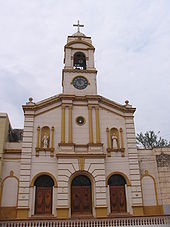- Culture of Paraguay
-
Paraguayans' cultural ancestry can be traced to the extensive intermarriage between the original male Spanish settlers and female indigenous Guaraní brides. Paraguayan culture therefore is a fusion of two things cultures and traditions: one European, the other Southern Guaraní. More than 93% of Paraguayans are mestizos, and this makes Paraguay one of the most homogeneous countries in Latin America. A characteristic of this cultural fusion is the extensive bilingualism present to this day: more than 80% of Paraguayans speak both Spanish and the indigenous language, Guaraní. Jopara, the mixture of Guaraní and Spanish, is also widely spoken.
This cultural fusion is expressed in arts such as embroidery (ao po'í) and lace making (ñandutí). The music of Paraguay, which consists of lilting polkas, bouncy galopas, and languid guaranías is played on the native harp. Paraguay's culinary heritage is also deeply influenced by this cultural fusion. Several popular dishes contain manioc, a local staple crop similar to the yuca root found in the Southwestern United States and Mexico, as well as other indigenous ingredients. A popular dish is sopa paraguaya, similar to a thick corn bread. Another notable food is chipa, a bagel-like bread made from cornmeal, manioc, and cheese. Many other dishes consist of different kinds of cheeses, onions, bell peppers, cottage cheese, cornmeal, milk, seasonings, butter, eggs and fresh corn kernels.
The 1950s and 1960s saw the flowering of a new generation of Paraguayan novelists and poets such as José Ricardo Mazó, Roque Vallejos, and Nobel Prize nominee Augusto Roa Bastos. Several Paraguayan films have been made.
Social life revolves largely around an extended family of parents, children and blood relations as well as godparents. The Paraguayans' chief loyalty is to their family, and it, in turn, is their haven and support. Family interests determine to a large extent which political party they will join, to whom they will marry, what sort of job they will get, whether they will win a lawsuit, and—in some cases—whether they would be wise to emigrate for a time. Even so, they are very heart warming and open to tourists and foreigners.
Inside the family, conservative values predominate. In lower classes, godparents have a special relationship to the family, since usually they are chosen because of their favorable social position, in order to provide extra security for the children. Particular respect is owed them, in return for which the family can expect protection and patronage.
Guinness World Record, barbecue
Mercosur country member Paraguay, on October 26, 2008, received the Guinness World Record "Biggest Barbecue in the World" record award from Judge Ralph Hannah. In the world's largest one day open-air barbecue, 30,000 people consumed 28 kilo tons of meat over 6 hours course in the Mariano Roque Alonso town-ship, at Asuncion. It erased the 1996 Philadelphia previous record, an 8-hour chow of 21.7 kilo tons.[1]
References
Latin American culture North America 
Central America Caribbean - Antigua and Barbuda
- Bahamas
- Barbados
- Cuba
- Dominica
- Dominican Republic
- Grenada
- Haiti
- Jamaica
- Puerto Rico1
- St. Kitts and Nevis
- St. Lucia
- St. Vincent and the Grenadines
- Trinidad and Tobago
South America - Dependencies not included.
- 1 Defined as a semi-autonomous territory.
Categories:- Paraguayan culture
Wikimedia Foundation. 2010.


